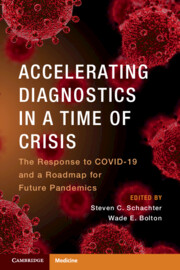 Accelerating Diagnostics in a Time of Crisis
Accelerating Diagnostics in a Time of Crisis Book contents
- Accelerating Diagnostics in a Time of Crisis
- Accelerating Diagnostics in a Time of Crisis
- Copyright page
- Dedication
- Contents
- Contributors
- Foreword
- Preface
- Acknowledgments
- Introduction
- Chapter 1 Early Detection, Response, and Surveillance of the COVID-19 Pandemic Crisis
- Chapter 2 Immunology of COVID-19 and Ineffective Immunity
- Chapter 3 Clinical Management: A Roadmap Based on One New York City Hospital’s Response to the COVID-19 Pandemic
- Chapter 4 Contribution of RADx® Tech to the Rapid Development of COVID-19 Diagnostic Tests
- Chapter 5 Coordination of Resources for the Manufacturing and Deployment of COVID-19 Diagnostic Assays
- Chapter 6 Quality and Risk Management Processes for Diagnostic Assays during an Emergency Pandemic Response
- Chapter 7 Development of Assays to Diagnose COVID-19
- Chapter 8 Laboratory Verification and Clinical Validation of COVID-19 Diagnostic Assays
- Chapter 9 Importance of Timely Sequencing, Tracking, and Surveillance of Emergent Variants
- Chapter 10 The RADx® Regulatory Core and Its Role in COVID-19 Emergency Use Authorizations
- Chapter 11 Commercialization and Market Assessment of COVID-19 Assays
- Chapter 12 Testing Strategies to Mitigate COVID-19 Disease Spread
- Chapter 13 A Pandemic Not Just of Infection but of Inequality: The Social Impact of COVID-19
- Chapter 14 Summary and Path Forward for Future Pandemics
- Index
- References
Chapter 2 - Immunology of COVID-19 and Ineffective Immunity
Published online by Cambridge University Press: 06 January 2024
- Accelerating Diagnostics in a Time of Crisis
- Accelerating Diagnostics in a Time of Crisis
- Copyright page
- Dedication
- Contents
- Contributors
- Foreword
- Preface
- Acknowledgments
- Introduction
- Chapter 1 Early Detection, Response, and Surveillance of the COVID-19 Pandemic Crisis
- Chapter 2 Immunology of COVID-19 and Ineffective Immunity
- Chapter 3 Clinical Management: A Roadmap Based on One New York City Hospital’s Response to the COVID-19 Pandemic
- Chapter 4 Contribution of RADx® Tech to the Rapid Development of COVID-19 Diagnostic Tests
- Chapter 5 Coordination of Resources for the Manufacturing and Deployment of COVID-19 Diagnostic Assays
- Chapter 6 Quality and Risk Management Processes for Diagnostic Assays during an Emergency Pandemic Response
- Chapter 7 Development of Assays to Diagnose COVID-19
- Chapter 8 Laboratory Verification and Clinical Validation of COVID-19 Diagnostic Assays
- Chapter 9 Importance of Timely Sequencing, Tracking, and Surveillance of Emergent Variants
- Chapter 10 The RADx® Regulatory Core and Its Role in COVID-19 Emergency Use Authorizations
- Chapter 11 Commercialization and Market Assessment of COVID-19 Assays
- Chapter 12 Testing Strategies to Mitigate COVID-19 Disease Spread
- Chapter 13 A Pandemic Not Just of Infection but of Inequality: The Social Impact of COVID-19
- Chapter 14 Summary and Path Forward for Future Pandemics
- Index
- References
Summary
For the purpose of this chapter, we are going to frame the immune response to severe acute respiratory syndrome coronavirus 2 (SARS-CoV-2) through a targeted and simplistic approach. SARS-CoV-2 invades and infects host cells via interaction of its spike protein with mucosal membrane receptor angiotensin-converting enzyme 2 (ACE2). The immune system response can be quite variable and depends on multiple factors, some specific to the virus and others specific to the patient’s immune competence or clinical comorbidities. SARS-CoV-2 can also be unusually effective at evading the triggering of early innate immune responses, such as type 1 interferons and related molecules. It is possible that much of the nature of COVID-19 as an illness is a consequence of this one evasion trick of SARS-CoV-2. In this chapter, we will describe this immune response and discuss mechanisms by which the virus actively seeks to evade our immune system. We will also discuss how we dissect the body’s immune response to assist us in identifying therapeutic and prophylactic targets and with the development of vaccines, and we will look at the effectiveness of these targets on morbidity and mortality and their adverse reaction profiles.
Keywords
- Type
- Chapter
- Information
- Accelerating Diagnostics in a Time of CrisisThe Response to COVID-19 and a Roadmap for Future Pandemics, pp. 31 - 49Publisher: Cambridge University PressPrint publication year: 2024
